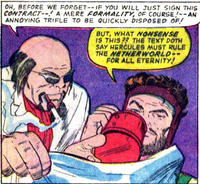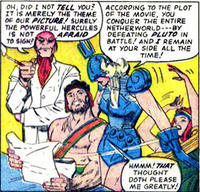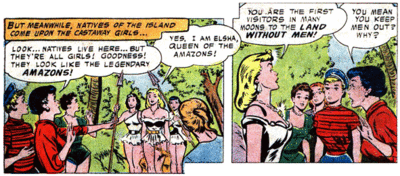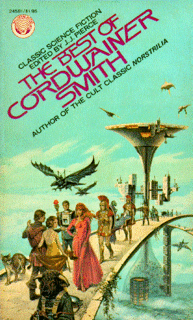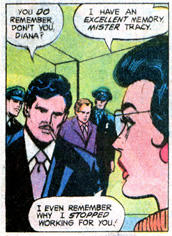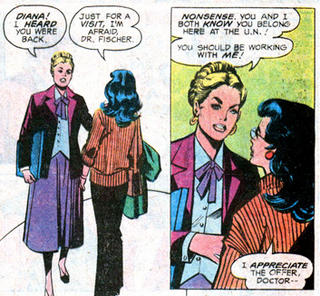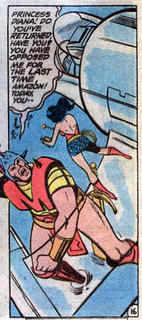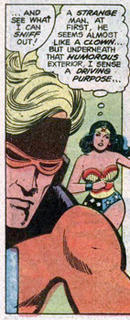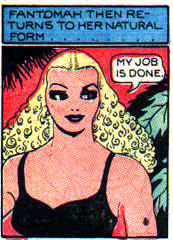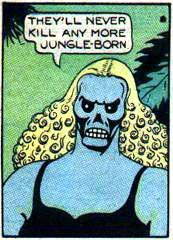Wonder Woman #252 - 253We now get to a story so big and stupid that it's going to take an entry all its own.
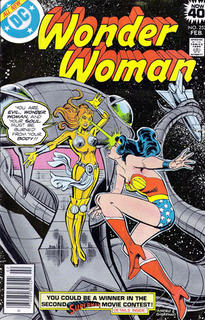
Jack C. Harris continues to demonstrate how he can beat about the bush with the wrong end of the stick in #252 as Wonder Woman commences her astronaut training (1). Cue the appearance of Astarte, Empress of the Silver Snake, mysterious gold skinned bimbo in a space bikini who is harassing passing space capsules. Luckily it's Wonder Woman she is after, so it's handy that WW has just become an unofficial support service for the space program. But first we have to meet Wonder Woman's new supporting cast, though there's no need to remember their names; they won't be around for long.
Once Wondy arrives Astarte claims she is evil, and so they have a big fight in space. But when Astarte sees Wonder Woman rescue the space shuttle that had got a bit squashed earlier in the story, she gets confused and turns into a lead statue (2). Harris's real gem for this issue is having the fight start in Earth orbit and then finish up on the Moon without any appreciable distance covered. Theoretically we could have missed the bit of the fight where WW gets slugged 220,000 miles, but if that's the case, why is the space shuttle still floating nearby when the catfight can't have affected it? And why is the villain named Astarte anyway?
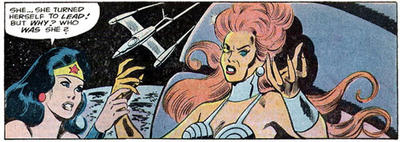
There is a cutaway scene with Queen Hippolyte biting her fingernails worrying that the gods will wreak some terrible revenge on Diana for leaving the island without permission(3), and she will be particularly vulnerable because the gods are so much more powerful in space (4), but even so they would have to be working in a particularly oblique and mysterious way to employ a goddess from a whole different pantheon to do so (5).
Issue #253 opens with the big snake shaped space ship of Astarte being examined by amazons on the Moon. Wonder Woman has called them in for no obvious reason (6) to tow it away or something. She says to her mother
"This lead statue was alive just an hour ago -- A creature of silver and gold..! When she changed to lead, I realised some kind of magic must be involved..." Way to spot the obvious, Princess.
She then explains how she repaired the space shuttle that had got a bit squashed in the fight (7)
"And with only 1/6th of Earth's gravity, my amazonian super-strength was multiplied -- allowing me to hurl it back into space towards Earth."(8)(9)

Astarte then wakes up and goes for Hippolyte's throat. The amazon technicians, all dressed in battle bikinis, attack with rayguns but are knocked backwards by the recoil due to the low gravity(10) and have to resort to swords instead(11). She then retreats, even though the swords are clearly not hurting her(12), saying
"You have made an enemy of me this day, Hippolyte -- and my vengence shall be devastating!" Which is a bit rich, since it was she who started the fight. She flies off in her snake ship but Hippolyte refuses to pursue her, on the basis that she seems familiar and she wants to check the amazon database in case it has anything on strange gold empresses who drive giant snake spaceships that might have slipped her mind.
So Wonder Woman decides it's time to get back to her day job where the astronaut trainees are practicing for the lack of gravity in space in NASA's Weightlessness Chamber(13). And then while Diana Prince slips into soap opera mode, pining for dead Steve Trevor and then snogging the nearest hunk for no good reason and then agonising about it, Astarte is watching from a rock on the far side of the Moon(14). And yet despite her phenomenal eyesight, when she shoots a beam at Diana, it misses her by several feet and causes the G-force simulator to come loose, which is irritating as Diana seems to believe that the simulator could go up to "
several hundred times the force of Earth's gravity" and I was looking forward to seeing the pilot being turned to jam when they cranked it up (15). Diana catches the rogue simulator and pauses only to have another page of angst before jumping into her robot plane and heading into space again.

Tracking Astarte by the radiation residue of her eye-beams (16), she meets up with a squadron of amazon fighters that hardly look like X-wings at all,
honest, and then they all jump out of their fighter planes to attack Astarte on foot with swords(17). Astarte immediately beats them by fusing their bracelets together, which takes all their strength away, or destroying their bracelets, which makes them foam at the mouth. She then steals Hippolyte's magic girdle which causes them to lose all the powers they hadn't already lost when she stuck their bracelets together. Meanwhile Wonder Woman has cleverly spotted that she knows all their weaknesses and asks her mother if she has worked out who this odd creature is.
And in fact it seems that Hippolyte has deduced that it is her dead sister, Diana, who had been killed by Hercules in the
Tales of the Amazons story in WW #247 even though she looks nothing like her and has, after all, been dead for at least a millenium. Perhaps the snake fetish gave her away.
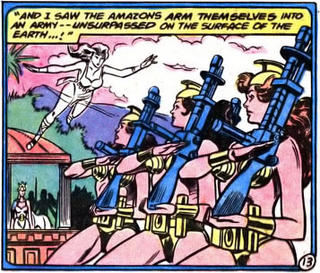
Astarte/Diana then relates how she watched the amazons build their society on Paradise Island in disembodied form but then grew weak and so flew out amongst the stars until she was attracted to a strange silver and gold asteroid. For no explained reason she is able to form a new body from this asteroid as well as create a spaceship shaped like a big snake. Returning to Earth, she finds that she is weakened if she gets too close to the planet, but luckily she has acquired such good eyesight now that she notices Wonder Woman beating up some guys from orbit, but assumes that WW is her own body inhabited my some evil spirit and so picks a fight with her. She never does explain why she calls herself by the name of a goddess from another pantheon, or what the whole "empress of the silver snake" thing was about, or even where she learned how to build a spaceship.
Apparently Hippo has never mentioned that she had a sister to her daughter, even though she not only named her Diana in honour of her fallen sibling, but apparently fashioned her to look exactly the same(18). Seems a bit remiss of her. Hippo then points out that Astarte/Diana is dead, which comes as a bit of a shock to her(19) and her body crumbles. Aphrodite and Athena then pop up, presumably to make sure she doesn't get lost on her way to Tartarus
this time, and Wonder Woman is left to ponder the infinite. And possibly why her mother is so secretive about the most unlikely things.
So what makes this story so terminally awful? Is it the deliberate effort made to insert factual information into the script and yet get it so horribly, horribly wrong? Is it the blatent plot devices that have no other purpose but to move the story along? The complete failure to explain anything that happens to Astarte from her death onwards? Hippolyte's curiously secretive "tribute" to her dead sister? A combination of all of this, probably. Though the fun with physics has to be a major factor.
Notes 1. which requires her to have a degree in maths, science, or engineering and logged 1,000 hours of flight time. Apparently she is also required to have excellent vision, which makes you wonder why no one has asked why she is wearing glasses.
2. you can only get this from the text as the colourist has failed to spot that Astarte should have changed colour at this point and she remains coloured gold for the rest of the issue (see pic above).
3. In issue #251. Not that it's any business of theirs anyway.
4. What the?
5. Astarte is the goddess of love, sometimes the goddess of love and war of the Phoenicians. She would be the equivalent of Aphrodite (ie. the Amazons' patron) from the greek pantheon.
6. It does make a certain amount of sense to have the amazons check it out for her, but since she never does this in any other story it's a bit of a blatent plot device.
7. One assumes that robot plane of hers must carry a good invisible toolkit.
8. I'm no physics geek but even I know the difference between weight and mass, and lower gravity would have made no difference to how much strength would have been required to throw it.
9. So Wonder Woman has just lobbed the space shuttle in the general direction of Earth from the Moon and assumes it will be fine, even though it was only intended to fly in Earth orbit and would not have had the fuel or the engines to deal with the situation. Hard to believe anyone writing about the space program during the 1970's could be so ignorant. Did Harris sleep through Apollo 13 or something?
10. What kind of raygun has recoil? Light beams do not have mass and so cannot cause recoil. Why include this kind of physics detail and get it so completely wrong?
11. They can't compensate for the recoil on a raygun but they are okay with swinging a heavy lump of metal around in 1/6th gravity? Amazon training seems a bit overly selective if you ask me.
12. It could happen.
13.One panel actually shows a sword going into her torso and poking out the other side, but this doesn't seem to bother her.
14. I'm sure NASA would love to have such a device but actually it's a little more difficult to simulate weightlessness. In fact the best NASA has managed so far is to take astronauts up in a big aircraft really high and then let it go into freefall, which gives about 30 seconds of weightlessness.
15. One panel shows the Moon between Astarte's rock and the Earth. She must have exceedingly good eyesight to not only see things more than 239,000 miles away, but through that much solid matter as well.
16. Fighter pilots are able to take around 8G on high speed turns before blacking out due to the blood being forced toward their extremeties and away from their brain. 200G would likely crush you to a thin smear of jelly.
17. Huh?
18. So when Hippo sculpted her as a baby from clay she did so with a clear idea of what she would look like as an adult?
19. It never occured to her all the time she was floating around as a ghost?
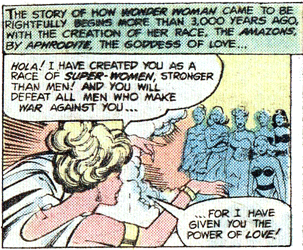 This is the Earth 1/Silver Age origin of Wonder Woman using the version published in DC Special Series #19 (November 1979) as the basis, with additions and variations from elsewhere as noted. I am not including references from the Golden Age version as that would just make things even more complicated.
This is the Earth 1/Silver Age origin of Wonder Woman using the version published in DC Special Series #19 (November 1979) as the basis, with additions and variations from elsewhere as noted. I am not including references from the Golden Age version as that would just make things even more complicated.
 The Amazons are originally created by Aphrodite as a race of super women (1) who will defeat all men that stand against them through force of arms because they have the power of love (2). She gives Queen Hippolyte (3) a magic girdle which makes them unconquerable. At Mars' direction Hercules eventually defeats them by seducing Hippolyte and stealing the magic girdle before enslaving them all. Hippolyte appeals to Aphrodite who frees them (4) but commands that they must forever after wear the wrist bands that chained them "to teach them the folly of submitting to men". Should a man ever chain them they will become as weak as a normal woman and if they ever remove them they will "lose all control of their emotions" (5).
The girdle is retrieved though Hippo's sister (6) Antiope, wife of Thesius (7) dies in the battle (8). Aphrodite decides to separate them from men completely and sends them off to Paradise Island and just to make sure, she decrees that no man may set foot there or the amazons would lose their powers (9).
The Amazons are originally created by Aphrodite as a race of super women (1) who will defeat all men that stand against them through force of arms because they have the power of love (2). She gives Queen Hippolyte (3) a magic girdle which makes them unconquerable. At Mars' direction Hercules eventually defeats them by seducing Hippolyte and stealing the magic girdle before enslaving them all. Hippolyte appeals to Aphrodite who frees them (4) but commands that they must forever after wear the wrist bands that chained them "to teach them the folly of submitting to men". Should a man ever chain them they will become as weak as a normal woman and if they ever remove them they will "lose all control of their emotions" (5).
The girdle is retrieved though Hippo's sister (6) Antiope, wife of Thesius (7) dies in the battle (8). Aphrodite decides to separate them from men completely and sends them off to Paradise Island and just to make sure, she decrees that no man may set foot there or the amazons would lose their powers (9).
 Oddly it never seems to occur to anyone that this is a bad weakness in their defences. If any enemy were to attack Paradise Island, all they would need to do would be to get one man onto the island for the amazons to lose their powers. Mars never takes advantage of this however, and in fact never attacks Paradise Island directly (10), so presumably he has some private understanding with Aphrodite about it.
At this point the story gets a little vague. We are told that the Amazons have been on Paradise Island for a thousand years, and Aphrodite does bring them the odd toy now and then, like the Magic Sphere (11) that allows them to keep up to date on the outside world, and indeed get well ahead of it on scientific advances (12). But after 900+ years Queen Hippolyte becomes sad for the lack of anyone to love other than all (13) the other amazons and so Athene directs her to sculpt an infant child (14) which is then brought to life by Aphrodite(15).
At this point in some versions of the story several other gods visit to imbue the infant Diana with special powers. Oddly, this includes Hercules. Perhaps after all this time he has reformed and wants to make amends for seducing and then mugging Hippolyte before subjecting the entire Amazon nation to slavery, the direct result of which was their cutting themselves off from the outside world and their stuck with wearing chunky bracelets for 1000 years. Sadly, in no version of the origin is this point addressed.
Oddly it never seems to occur to anyone that this is a bad weakness in their defences. If any enemy were to attack Paradise Island, all they would need to do would be to get one man onto the island for the amazons to lose their powers. Mars never takes advantage of this however, and in fact never attacks Paradise Island directly (10), so presumably he has some private understanding with Aphrodite about it.
At this point the story gets a little vague. We are told that the Amazons have been on Paradise Island for a thousand years, and Aphrodite does bring them the odd toy now and then, like the Magic Sphere (11) that allows them to keep up to date on the outside world, and indeed get well ahead of it on scientific advances (12). But after 900+ years Queen Hippolyte becomes sad for the lack of anyone to love other than all (13) the other amazons and so Athene directs her to sculpt an infant child (14) which is then brought to life by Aphrodite(15).
At this point in some versions of the story several other gods visit to imbue the infant Diana with special powers. Oddly, this includes Hercules. Perhaps after all this time he has reformed and wants to make amends for seducing and then mugging Hippolyte before subjecting the entire Amazon nation to slavery, the direct result of which was their cutting themselves off from the outside world and their stuck with wearing chunky bracelets for 1000 years. Sadly, in no version of the origin is this point addressed.
 What many consider to be the first Silver Age version of the origin story (16) appears in Wonder Woman #105, and although it is the first to involve the gods doing their fairy godmother routine, it does so in a context that is inconsistent with every other version of the story. Here Diana is born well before the Amazons go into isolation, and they only do so because all their menfolk have died in the wars and they just want to
What many consider to be the first Silver Age version of the origin story (16) appears in Wonder Woman #105, and although it is the first to involve the gods doing their fairy godmother routine, it does so in a context that is inconsistent with every other version of the story. Here Diana is born well before the Amazons go into isolation, and they only do so because all their menfolk have died in the wars and they just want to 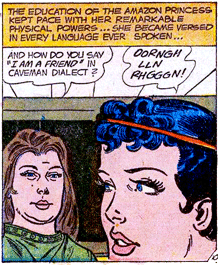 cut themselves off from such a savage world. In fact here Diana as a teenager builds the ship (17) they leave in. Its only claim to accuracy anywhere is the gods’ gift, which is grafted onto later versions of the story. Seen purely in context with earlier versions it is one big mess of inaccuracies and omissions.
Things then start to get a little surreal. As Diana grows up she is often referred to first as Wonder Tot and later Wonder Girl. At both periods of her life she wears an outfit that contains motifs from the costume she wears as Wonder Woman. We are even shown her performing trials to win these motifs as a teenager. She and her mother are fully aware of her destiny as Wonder Woman as they have a device that allows them to observe her future adventures.
cut themselves off from such a savage world. In fact here Diana as a teenager builds the ship (17) they leave in. Its only claim to accuracy anywhere is the gods’ gift, which is grafted onto later versions of the story. Seen purely in context with earlier versions it is one big mess of inaccuracies and omissions.
Things then start to get a little surreal. As Diana grows up she is often referred to first as Wonder Tot and later Wonder Girl. At both periods of her life she wears an outfit that contains motifs from the costume she wears as Wonder Woman. We are even shown her performing trials to win these motifs as a teenager. She and her mother are fully aware of her destiny as Wonder Woman as they have a device that allows them to observe her future adventures.
 The final act of the story opens with Steve Trevor crashing an aircraft near Paradise Island. Diana rescues him and nurses him back to health. The rules about no man setting foot on the island are here severely strained as the spirit of the law is broken even if the letter of the law is observed. Diana carries Steve onto the island and he then spends his time on tables or in beds to avoid so much as a toe making contact with the floor. I am assuming that this is one of the many exceptions Aphrodite makes (18) as she seems to have set the whole thing up.
The final act of the story opens with Steve Trevor crashing an aircraft near Paradise Island. Diana rescues him and nurses him back to health. The rules about no man setting foot on the island are here severely strained as the spirit of the law is broken even if the letter of the law is observed. Diana carries Steve onto the island and he then spends his time on tables or in beds to avoid so much as a toe making contact with the floor. I am assuming that this is one of the many exceptions Aphrodite makes (18) as she seems to have set the whole thing up.
 Hippolyte consults Aphrodite who tells her that an Amazon (19) must escort the man home and stay to fight against evil and injustice. Hippolyte declares a contest to choose who will get the honour despite the fact that she has known for years that Diana will win it. I can only assume that she's been sniffing the mists of Nepenthe. She even forbids Diana to take part because she can't bear to let her go, but Diana enters anyway, wearing an unconvincingly small mask. Either the other Amazons are extremely stupid or they must be humouring her by pretending that they are at all fooled by it (20).
Inevitably, Diana wins the contest. Probably because of those powers the gods gave her at birth. She is given her costume that Aphrodite has cunningly designed for her incorporating patriotic symbols of the country to which she is heading. Aphrodite has also directed Hippolyte to take some links from her magic girdle to create a magic lasso. Diana flies Steve back to America in her magic invisible robot plane which she just happened to have lying around (21).
Hippolyte consults Aphrodite who tells her that an Amazon (19) must escort the man home and stay to fight against evil and injustice. Hippolyte declares a contest to choose who will get the honour despite the fact that she has known for years that Diana will win it. I can only assume that she's been sniffing the mists of Nepenthe. She even forbids Diana to take part because she can't bear to let her go, but Diana enters anyway, wearing an unconvincingly small mask. Either the other Amazons are extremely stupid or they must be humouring her by pretending that they are at all fooled by it (20).
Inevitably, Diana wins the contest. Probably because of those powers the gods gave her at birth. She is given her costume that Aphrodite has cunningly designed for her incorporating patriotic symbols of the country to which she is heading. Aphrodite has also directed Hippolyte to take some links from her magic girdle to create a magic lasso. Diana flies Steve back to America in her magic invisible robot plane which she just happened to have lying around (21).
 Arriving in America, Diana is a bit mystified as to what to do next. Although the Amazons have been observing the outside world for centuries and looting it for technological advances she seems oddly unprepared for her situation (22). Eventually she bumps into a crying nurse who coincidently is her identical twin, has the same name, and is tending Steve Trevor. Wonder Woman finances a trip to South America for her in exchange for her identity. There are several mutually exclusive variations on what becomes of this woman later, though all but one (23) refer to the golden age/Earth 2 Wonder Woman.
And so established as a nurse in a military hospital where security is so lax that nobody notices the difference, Princess Diana becomes Diana Prince and nurses Steve Trevor back to health. When Steve returns to duty she follows him and somehow manages to get a job as his secretary in Military Intelligence (24) and spends many years having a chaste romance with him despite his treating her like a servant in her secret identity and alternately nagging her to marry him or exhibiting bouts of insane jealousy when she is in her heroic identity and they live happily ever after until he drops dead, gets resurrected, dies again, and is finally replaced by an alternate version from another dimension.
Notes
1. from clay according to #159
2. no, I’ve never quite understood how that works, either
3. often spelled Hippolyta
4. or supports them when they free themselves
5. invariably this is depicted as running berserk with overwhelming anger and never any other emotion, which suggests they must be repressing a lot normally, and somehow it doesn't seem to apply to Diana when in her secret identity.
6. if they were all created simultaneously by Aphrodite surely they are all sisters?
7. only mention that the amazons had anything to do with men.
8. in #247 it is an Amazon called Diana who dies at this point
9. other consequences appear to be them losing their immortality and crumbling to dust (#223) earthquakes, and sundry disasters, or immediately falling in love with the visitor (#216), although Aphrodite seems to suspend this law as it suits her (25)
10. except #198 when he is wearing a false beard, calling himself Ares, and claiming Hippolyte is his daughter, but perhaps this is an alternate dimension Ares/Mars.
11. it's a disc.
12. though we never, ever see any of the infrastructure required to create their advanced society. Where are the mines, refineries, factories, etc? It’s not like they can import anything.
13. how many women make up the Amazon nation is also very unclear, as is the size of the island they live on.
14. she usually looks like a toddler, so Hippo is cunningly bypassing all that midnight feeding and diaper changing business.
15. the addition of a second infant only appears in #206 and is otherwise ignored.
16. there’s one in #97 but I’ll probably end up doing a whole separate article to explain why this should be ignored.
17. how many can one ship hold? All the main versions only show them using a single ship, which rather limits the size of the population. See (13).
18. without telling the amazons.
19. in Secret Origins she specifically states "a young Amazon". Since no men are allowed on Paradise Island, they are either kidnapping girls from the outside world or cloning themselves, because otherwise the only young Amazon is Diana. What a giveaway.
20. They are a small closed society who have been together for a thousand years. It is absurd to think that everyone would not know everyone else. They would immediately know who the masked one was, if only by a process of elimination.
21. in Golden Age continuity each of these items is quested for separately.
22. though not as unprepared as Orana in #250 who is so utterly clueless that she mistakes policemen for villains.
23. issue #172.
24. the story glosses over this part.
25. she must have a soft spot for I-Ching, who is allowed to visit in #198 without any problems; unless he is secretly a female transvestite or had a sex change
Arriving in America, Diana is a bit mystified as to what to do next. Although the Amazons have been observing the outside world for centuries and looting it for technological advances she seems oddly unprepared for her situation (22). Eventually she bumps into a crying nurse who coincidently is her identical twin, has the same name, and is tending Steve Trevor. Wonder Woman finances a trip to South America for her in exchange for her identity. There are several mutually exclusive variations on what becomes of this woman later, though all but one (23) refer to the golden age/Earth 2 Wonder Woman.
And so established as a nurse in a military hospital where security is so lax that nobody notices the difference, Princess Diana becomes Diana Prince and nurses Steve Trevor back to health. When Steve returns to duty she follows him and somehow manages to get a job as his secretary in Military Intelligence (24) and spends many years having a chaste romance with him despite his treating her like a servant in her secret identity and alternately nagging her to marry him or exhibiting bouts of insane jealousy when she is in her heroic identity and they live happily ever after until he drops dead, gets resurrected, dies again, and is finally replaced by an alternate version from another dimension.
Notes
1. from clay according to #159
2. no, I’ve never quite understood how that works, either
3. often spelled Hippolyta
4. or supports them when they free themselves
5. invariably this is depicted as running berserk with overwhelming anger and never any other emotion, which suggests they must be repressing a lot normally, and somehow it doesn't seem to apply to Diana when in her secret identity.
6. if they were all created simultaneously by Aphrodite surely they are all sisters?
7. only mention that the amazons had anything to do with men.
8. in #247 it is an Amazon called Diana who dies at this point
9. other consequences appear to be them losing their immortality and crumbling to dust (#223) earthquakes, and sundry disasters, or immediately falling in love with the visitor (#216), although Aphrodite seems to suspend this law as it suits her (25)
10. except #198 when he is wearing a false beard, calling himself Ares, and claiming Hippolyte is his daughter, but perhaps this is an alternate dimension Ares/Mars.
11. it's a disc.
12. though we never, ever see any of the infrastructure required to create their advanced society. Where are the mines, refineries, factories, etc? It’s not like they can import anything.
13. how many women make up the Amazon nation is also very unclear, as is the size of the island they live on.
14. she usually looks like a toddler, so Hippo is cunningly bypassing all that midnight feeding and diaper changing business.
15. the addition of a second infant only appears in #206 and is otherwise ignored.
16. there’s one in #97 but I’ll probably end up doing a whole separate article to explain why this should be ignored.
17. how many can one ship hold? All the main versions only show them using a single ship, which rather limits the size of the population. See (13).
18. without telling the amazons.
19. in Secret Origins she specifically states "a young Amazon". Since no men are allowed on Paradise Island, they are either kidnapping girls from the outside world or cloning themselves, because otherwise the only young Amazon is Diana. What a giveaway.
20. They are a small closed society who have been together for a thousand years. It is absurd to think that everyone would not know everyone else. They would immediately know who the masked one was, if only by a process of elimination.
21. in Golden Age continuity each of these items is quested for separately.
22. though not as unprepared as Orana in #250 who is so utterly clueless that she mistakes policemen for villains.
23. issue #172.
24. the story glosses over this part.
25. she must have a soft spot for I-Ching, who is allowed to visit in #198 without any problems; unless he is secretly a female transvestite or had a sex change




